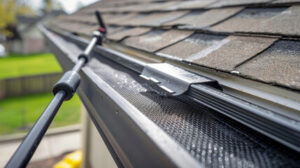Professional gutter guard installation may cost more than DIY, but it offers peace of mind that the job was done correctly and reduces risk of damage to your home. The initial cost of gutter guards can be offset by savings on future maintenance costs and added home value.

Gutter Guard Charleston helps prevent clogs by ensuring that water flows freely and that debris falls to the ground. The best styles also discourage insects, rodents, and other pests from nesting in damp gutters.
Gutters help channel water away from your house, which prevents foundation damage and protects your home’s value. Unfortunately, gutters can get clogged with debris and become ineffective. The result is water that pools around your foundation and can cause soil erosion, basement flooding, wood rot, and mold growth. Gutter guards make the gutter system more effective and reduce the need for frequent cleaning, avoiding these costly issues.
When gutters are clogged, it’s easy for water to seep into the fascia boards and shingles, or even into the attic or basement. This can cause rotting, mold and moss growth, and lead to a variety of serious problems over time. With working, topped-off gutters, water flows freely and avoids these damages.
The decision of whether to install gutter guards yourself or hire a professional will depend on your comfort level with DIY projects and budget. DIY installations can be cost-effective but may also come with a higher risk of mistakes and safety risks. Professional installation can cost more but also comes with warranties and insurance coverage that minimizes financial liability.
When it comes to gutter guards, there is a wide range of options, including foam, mesh, and reverse curve designs. Your specific needs and installation preference will determine which product is best for your home, and this decision will likely also be influenced by the climate of your area and the types of debris you deal with. The CoMo Premium Exteriors team can provide valuable guidance during a consultation to ensure you choose the right solution for your unique situation and property. We can also help you with the proper installation, ensuring your new gutter guards are functioning at their peak and protecting your home.
Prevents Clogs
Clogged gutters can cause water to overflow and potentially damage the foundation of your home. Gutter guards can prevent clogs and keep water flowing away from your house.
Many different styles of gutter guards are available. It is important to choose the right one for your home and the environment. Consider factors such as your roof type, the amount of debris your property typically encounters, and the amount of rainfall you experience. The professionals at CoMo Premium Exteriors can help you navigate the various options to find a solution that fits your home perfectly and provides optimal protection.
Gutter guards can prevent clogs by keeping water flowing and filtering out debris. However, they cannot prevent clogs caused by trees or debris from falling onto your roof. You will still need to maintain your gutters regularly to remove any accumulated debris.
However, if you have gutter guards in place, it will be much easier to clean out your gutters. They can also reduce the frequency of maintenance you need to perform, saving you time and effort. This can make your home safer and more attractive. It can also help prevent the need to climb a ladder to clean your gutters, which can be dangerous for older homeowners. Gutter guards also make it easier to prevent ice dams in the winter.
Deters Pests
Gutter guards deter pest infestations by keeping critters like birds, rodents, and insects out of your gutters. Without gutter covers, clogged gutters become an ideal place for pests to nest and breed, increasing the risk of pest infestation throughout your home. Gutter guards block the nesting areas and prevent clogging, minimizing pest problems and maintaining proper water flow.
Clogged gutters can also lead to wood rot and mold, which can affect your roof and siding. Gutter guards protect your home from this damage by preventing the build-up of small debris, such as pine needles and dirt, that can collect in your gutters and create a breeding ground for pests. Gutter guards also extend the life of your gutters by reducing rusting and maintaining proper flow, which can reduce the need for maintenance or replacement.
Gutters are an important part of your home, channeling rainwater away from the foundation and walls to prevent soil erosion, basement flooding, and foundation cracks. However, improperly functioning gutters can cause extensive damages. The most common problem is that clogged gutters become a haven for pests, leading to a variety of issues including rotting leaves and twigs, standing water, and mold growth. The best way to prevent these pests is by reinforcing your gutter system with protective coverings. Gutter guards are a cost-effective and easy-to-install solution that will improve your home’s drainage efficiency while deterring pests and maintaining your property’s value. Gutter covers are available in a range of styles to suit your home’s needs and budget, including micro-mesh, mesh, reverse curve, and surface tension. A professional can help you choose the right type for your needs and ensure a long-lasting, high-quality product.
Reduces Water Damage
Many homeowners purchase gutter guards with the hopes of never having to clean their gutters again. Unfortunately, they end up with what we like to call “filter regret” – the realization that their expensive gutter protection system actually let debris and water into their homes. This is usually due to shoddy installation practices or ineffective gutter protection systems. Gutter guards with large holes, gaps and openings will quickly become clogged and allow debris to wash away, while hood systems and do-it-yourself systems often feature flimsy designs that are not backed by warranties. These flimsy gutter protection systems will easily buckle under the weight of debris and may even leak, causing costly damage to fascia and soffit boards.
Other problems caused by poor-quality gutter guards include wood rot and mold. Inadequate gutter guards may also result in overflow, which can cause water damage to your home’s foundation and basement. This type of water damage can be very expensive to repair and can even cause foundation cracks that threaten your home’s safety and integrity.
In addition, clogged gutters can lead to water overflow, which can affect your yard and landscaping. This can make your property look dirty and unkempt, as well as attract pests such as birds and squirrels looking for a place to nest.
Ultimately, gutter guards can significantly reduce the frequency with which you need to clean your home’s gutters. They can keep them clear of debris and improve the overall health and function of your gutter system. However, they are not a complete solution to all your gutter maintenance needs and should be regularly inspected for damage and cleaning. If you are interested in protecting your home from water damage, contact a Ned Stevens professional to learn more about the benefits of gutter guard.
Maintains Curb Appeal
Gutter guards help maintain a home’s overall value and curb appeal by preventing clogs, pest infestations, water damage, and more. They also prevent the need for regular gutter cleaning and maintenance, saving homeowners time and money in the long run.
The best gutter cover for your needs will depend on the type of debris in your area and the style of your home’s gutters. A professional can help you choose the right product for your home.
Aluminum gutter covers are designed to fit over the top of your gutters, preventing debris from entering the system. They’re also durable and rust-resistant, making them a great option for homes in harsh climates. They come in a variety of colors to match your home’s exterior and are available at a range of prices.
Mesh gutter covers are made of fine mesh that allows rainwater to flow through while blocking debris, making them an affordable and effective choice for homeowners. They’re designed to fit over existing gutters and are easy to install.
Other gutter guard types include brush gutter covers, reverse curve gutter covers, and solid cover gutters. Brush guards have outward bristles that can push away debris and dead leaves to the ground. However, they can also trap smaller debris like pine needles, seeds, and dirt, requiring regular cleaning to prevent blockages and clogs.
Reverse curve gutter covers work by channeling water downward through a tiny slit and encouraging leaves to fall over the edge of the gutter. These are also fairly easy to install but can break easily during cleaning or ice dams. Solid cover gutters are made of thick metal and require professional installation.








